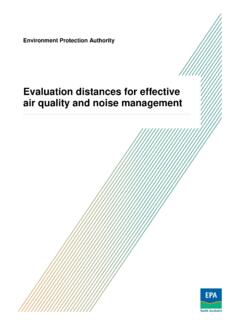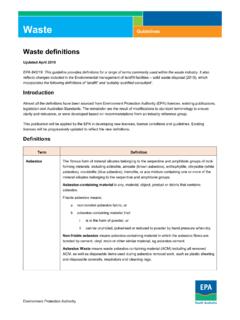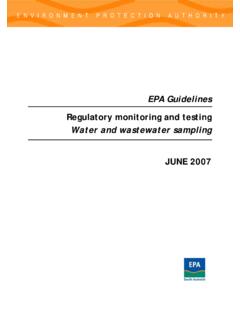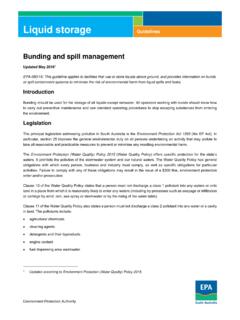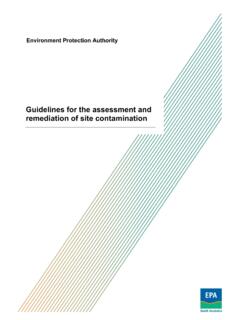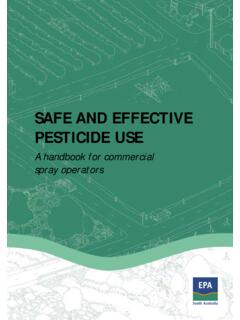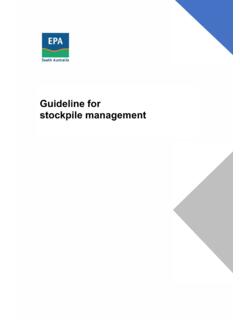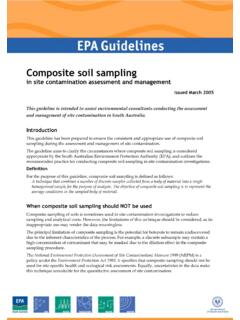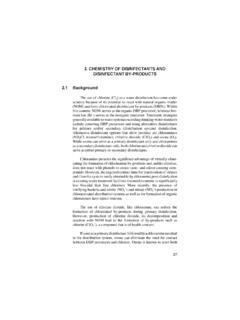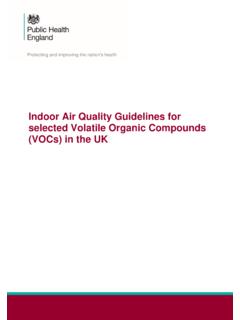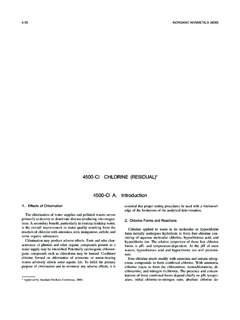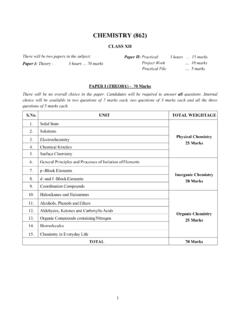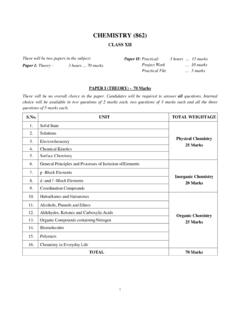Transcription of EPA Information - Photochemical smog — what it means for us
1 Photochemical smog what it means for us March 2004 EPA 90/04: This document replaces the EPA Information Sheet No. 21, Photochemical Smog (August 2000). It explains what Photochemical smog is and the dangers it poses to environmental and human health, as well as providing Information on how Photochemical smog can be reduced. Introduction Although Adelaide does not experience Photochemical smog to the same extent as larger cities, such as Sydney and Los Angeles, the characteristic brown haze can still be seen at various times over the city. The main sources of pollution affecting air quality in the Adelaide metropolitan area are motor vehicles and domestic wood-burning heaters, while in regional centres industry often has the largest impact. The Environment Protection Authority (EPA) monitors the pollutants in our air at a number of metropolitan and regional locations to determine whether the air quality is satisfactory for maintaining human health and well-being.
2 The air quality monitoring program has been covering metropolitan Adelaide for more than a decade and has been extended to two sites in Whyalla, and one in Mt Gambier, with a sixth site under construction in Port Pirie. Metropolitan and regional air quality in South Australia is generally good, although there are occasions when levels of pollutants (mainly particulate matter very small particles floating in the air) exceed national guidelines, mostly due to wind-blown dust, or high traffic flow and congestion on warm, sunny days. Industrial development in some regional centres can also create higher particulate levels. South Australia, like the rest of the country, needs to continue to assess the amount of pollutants being produced and ensure that all possible measures are taken to reduce the occurrence of Photochemical smog. Photochemical smog: what it means for us March 2004 What are the dangers?
3 Photochemical smog can have an effect on the environment, on people s health and even on various materials. The main visible effect is the brown haze that can be seen above many cities. The brown tinge is caused by very small liquid and solid particles scattering the light. Plants Chemicals such as nitrogen oxides, ozone and peroxyacetyl nitrate (PAN) can have harmful effects on plants. These substances can reduce or even stop growth in plants by reducing photosynthesis. ozone , even in small quantities, can achieve this, but PAN is even more toxic to plants than ozone . Health The biggest concern about Photochemical smog is the effect it has on people s health. The effects of the major primary and secondary pollutants in smog are given in Table 1. Table 1 Health effects of pollutants involved in Photochemical smog Pollutant Effects Nitrogen oxides can contribute to problems with heart and lungs links to decreased resistance to infection Volatile organic compounds (VOCs) eye irritation respiratory problems some compounds are carcinogens ozone coughing and wheezing eye irritation respiratory problems (particularly for conditions such as asthma) Peroxyacetyl nitrate (PAN) eye irritation respiratory problems Materials ozone can damage various compounds.
4 It can cause the cracking of rubber, the reduction in tensile strength of textiles, fading of dyed fibres and cracking of paint. ozone s potential to damage artworks and books is of cultural importance, and some museums and libraries have taken steps to minimise this effect. What is Photochemical smog? Photochemical smog is a mixture of pollutants that are formed when nitrogen oxides and volatile organic compounds (VOCs) react to sunlight, creating a brown haze above cities. It tends to occur more often in summer, because that is when we have the most sunlight. Primary pollutants The two major primary pollutants, nitrogen oxides and VOCs, combine to change in sunlight in a series of chemical reactions , outlined below, to create what are known as secondary pollutants. Secondary pollutants The secondary pollutant that causes the most concern is the ozone that forms at ground level.
5 While ozone is produced naturally in the upper atmosphere, it is a dangerous substance when found at ground level. Many other hazardous substances are also formed, such as peroxyacetyl nitrate (PAN). page 2 Photochemical smog: what it means for us March 2004 What are the major sources of Photochemical smog? While nitrogen oxides and VOCs are produced biogenically (in nature), there are also major anthropogenic (man-made) emissions of both. Natural emissions tend to be spread over large areas, reducing their effects, but man-made emissions tend to be concentrated close to their source, such as a city. Biogenic sources In nature, bushfires, lightning and the microbial processes that occur in soil generate nitrogen oxides. VOCs are produced from the evaporation of naturally-occurring compounds, such as terpenes, which are the hydrocarbons in oils that make them burn.
6 Eucalypts have also been found to release significant amounts of these compounds. Anthropogenic sources Nitrogen oxides are produced mainly from the combustion of fossil fuels, particularly in power stations and motor vehicles. VOCs are formed from the incomplete combustion of fossil fuels, from the evaporation of solvents and fuels, and from burning plant matter such as backyard burning and wood-burning stoves. In Adelaide in 2000, an estimated 66% of nitrogen oxides (NO and NO2) came from motor vehicles, and a further 20% from fuel combustion. Motor vehicles contributed 44% of VOC emissions, and area sources including petrol and solvent evaporation contributed 33%. How is smog formed? Below is a simplified explanation of the chemistry of smog formation. Nitrogen dioxide (NO2) can be broken down by sunlight to form nitric oxide (NO) and an oxygen radical (O): 1) NO2 + NO + Osunlight Oxygen radicals can then react with atmospheric oxygen (O2) to form ozone (O3): 2) O + O2 O3 ozone is consumed by nitric oxide to produce nitrogen dioxide and oxygen: 3) O3 + NO2 + O2NO Harmful products, such as PAN, are produced by reactions of nitrogen dioxide with various hydrocarbons (R), which are compounds made from carbon, hydrogen and other substances: 4) NO2 + R products such as PAN The main source of these hydrocarbons is the VOCs.
7 Similarly, oxygenated organic and inorganic compounds (ROx) react with nitric oxide to produce more nitrogen oxides: page 3 Photochemical smog: what it means for us March 2004 5) NO + ROx NO2 + other products The significance of the presence of the VOCs in these last two reactions is paramount. ozone is normally consumed by nitric oxide, as in reaction 3. However, when VOCs are present, nitric oxide and nitrogen dioxide are consumed as in reactions 4 and 5, allowing the build up of ground level ozone . How location and weather can have an effect Topography The topography of the area surrounding a city can vastly influence the formation of Photochemical smog. Because of the restriction of air movement, a city in a valley can experience problems that a city on an open plain may not. A city such as Adelaide can experience restrictions of air movement because of its position between the coast and the Adelaide Hills.
8 Meteorology Normally the layer of air closest to the earth s surface is warmer than the air higher in the atmosphere because the heat of the sun is re-radiated (warmed by the earth s surface). The higher level cool air sinks and is then warmed and displaced upwards in a convection cycle (Figure 1). This condition is called unstable and helps to carry pollutants upwards, where they are dispersed and diluted. This cycle is usually assisted by higher wind speeds. However, when the opposite occurs a temperature inversion cities can experience prolonged periods of Photochemical smog. An inversion is formed when a ceiling of warmer air traps the cooler layer of air, which contains the pollutants, near the ground s surface. This hinders the ability of the pollutants to rise to the atmosphere and be dispersed. After an inversion has formed, it keeps any smog that is present close to the ground, maximising its detrimental effect.
9 There are two major processes that enable an inversion to happen and both are usually accompanied by low wind speeds. The first, advection, is when an upper layer of warmer air is blown in, trapping the layer of cool air below it. This stable condition may last for several days. A variation of this is when a cooler layer of air, such as a sea breeze, is blown in underneath a warmer layer, creating the same effect. The second process, radiation inversion, usually occurs overnight. The ground cools and in turn cools the air layer closest to it, resulting in the lower air layer being cooler than air above it, forming an inversion. page 4 Photochemical smog: what it means for us March 2004 ir ll air Low level air is warmed Warm arises Cool air sinks Higher eveis cooled Re-radiation of the Earth s surface sun s energy Figure 1 A convection cycle.
10 How can we reduce the occurrence of Photochemical smog? The most effective way of reducing the amount of secondary pollutants created in the air is to reduce emissions of both primary pollutants. Reduction of nitrogen oxide The main method of lowering the levels of nitrogen oxides is by a process called catalytic reduction , which is used in industry and in motor vehicles. For example, a catalytic converter fitted to a car s exhaust system will convert much of the nitric oxide from the engine exhaust gases to nitrogen and oxygen. In Australia, all motor vehicles built after 1985 must be fitted with catalytic converters. Nitrogen is not in the actual fuels used in motor vehicles or power stations; it is introduced from the air when combustion occurs. Using less air in combustion can reduce emissions of nitrogen oxides. Temperature also has an effect on emissions the lower the temperature of combustion, the lower the production of nitrogen oxides.
